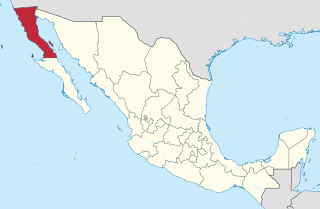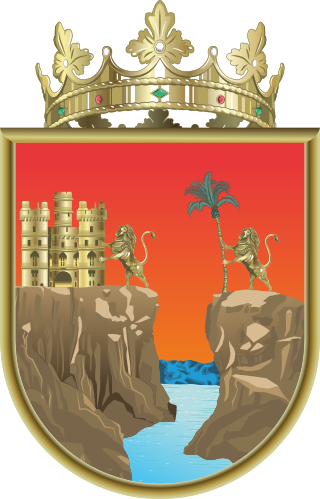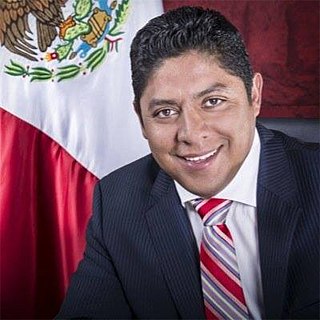
The United Mexican States is a federal republic composed of 32 federal entities: 31 states and Mexico City, an autonomous entity. According to the Constitution of 1917, the states of the federation are free and sovereign in all matters concerning their internal affairs. Each state has its own congress and constitution.

Baja California, officially Estado Libre y Soberano de Baja California, is a state in Mexico. It is the northernmost and westernmost of the 32 federal entities of Mexico. Before becoming a state in 1952, the area was known as the North Territory of Baja California. It has an area of 70,113 km2 (27,071 sq mi) and comprises the northern half of the Baja California Peninsula, north of the 28th parallel, plus oceanic Guadalupe Island. The mainland portion of the state is bordered on the west by the Pacific Ocean; on the east by Sonora, the U.S. state of Arizona, and the Gulf of California; on the north by the U.S. state of California; and on the south by Baja California Sur.

The Mexican state of Nuevo León has been governed by more than a hundred individuals in its history, who have had various titles and degrees of responsibility depending on the prevailing political regime of the time.

The governor of Chiapas is the chief executive of the Mexican state of Chiapas. The state constitution stipulates a term of 6 years, to which governors can only be elected once. It also specifies the qualifications for becoming governor: a Mexican citizen by birth, aged at least 30 years old, and having not less than 5 years residency in Chiapas. The current governor is Rutilio Escandón from the MRN, who assumed the position in 2018.
Héctor Téran Terán was a Mexican politician, member of the National Action Party (PAN), and Governor of Baja California.

The governor, according to the Political Constitution of the Free and Sovereign State of Veracruz de Ignacio de la Llave in Mexico, the Executive Power is invested in one individual, called "Constitutional Governor of the Free and Sovereign State of Veracruz de Ignacio de la Llave". The current governor is Cuitláhuac García Jiménez, who assumed the position on December 1, 2018. He is a member of the National Regeneration Movement.

The governor of Tlaxcala is the position representing the complete executive power of the government of the Mexican state of Tlaxcala, per the Political Constitution of the Free and Sovereign State of Tlaxcala.

The governor of San Luis Potosí exercises the role of the executive branch of government in the Mexican state of San Luis Potosí, per the Political Constitution of the Free and Sovereign State of San Luis Potosí. The official title is Gobernador Constitucional del Estado Libre y Soberano de San Luis Potosí.
Carlos Trejo Lerdo de Tejada was a Mexican politician and diplomat. Carlos Trejo y Lerdo de Tejada was a Mexican politician, lawyer, and diplomat who served as the governor of the Northern Territory of Baja California.

Jaime Bonilla Valdez is a Mexican politician and entrepreneur who served as the Governor of Baja California from 2019 to 2021. A member of the National Regeneration Movement party, he has been a Federal Congressman and a Senator of the Republic.
Events in the year 1952 in Mexico.
Events in the year 1955 in Mexico.
Events in the year 1962 in Mexico.
Events in the year 1964 in Mexico.
Events in the year 1969 in Mexico.

The Governor of the Bank of Spain is the head of the Bank of Spain, the central bank of the Kingdom of Spain. The Bank of Spain is integrated in the European System of Central Banks and, as such, the Governor is an ex officio member of the Governing Council of the European Central Bank.
Gustavo Aubanel Vallejo was a Mexican physician and politician who served as the first municipal president of Tijuana and third governor of Baja California from 1964 to 1965, after the death of Eligio Esquivel Méndez.










